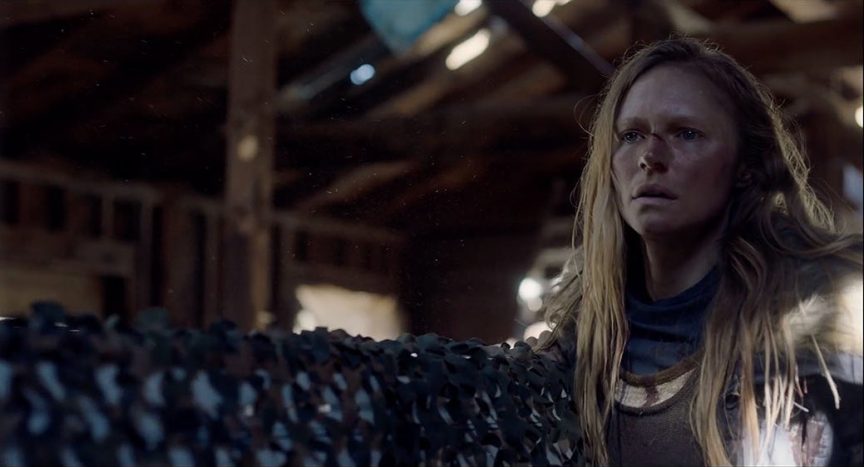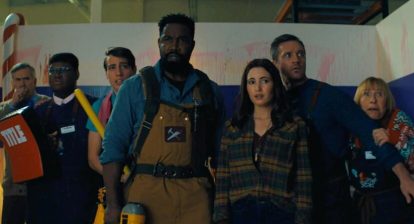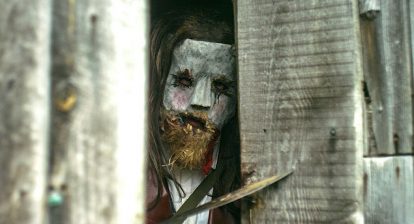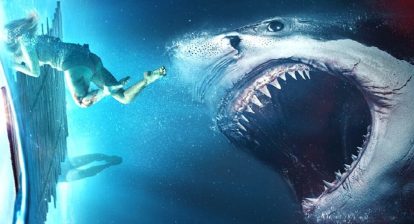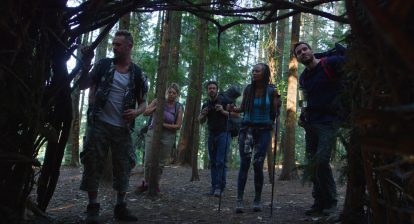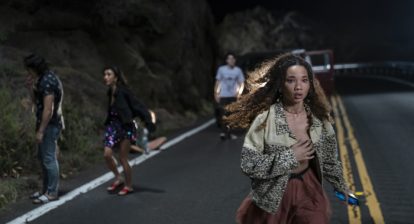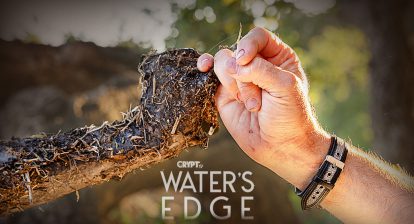There is no denying that horror films normally follow a specific formula and have their own set of rules, production wise. Humans react to the unpredictable—or react to what they expect—and in horror you then have to mix those thoughts up. Whether it be with the use of shadows and lighting, camera angles or quick edits, to make a good horror film, you always have to keep the audience on their toes. Cinematographer Jimmy Matolsz knows these tricks very well, having been in the business for over 20 years and worked on everything from Nike commercials to Starship Troopers. His latest feature, Devilworks’ horror- thriller F.E.A.R., follows a family fighting to save their children against a band of marauders, hellbent on revenge after a terrifying pathogen was released. To celebrate the recent release, we conducted the below Q&A with Matlosz and had him discuss everything F.E.A.R..
Wicked Horror: The opening shot of the film is an aerial shot of the snowy mountainside. What did you use to shoot this?
Jimmy Matlosz: Curious that that is your first question, that was second unit, lol, as often with any feature. And yes, even our low budget film had a second unit for drone work, I believe it was a DJI Phantom, so all that said, operated by Danny Welden and Jason Welden. I set the parameters for exposure, that’s about it, it was directed by Jason and Geoff.

Wicked Horror: What scene in F.E.A.R. was the most difficult to shoot? Why?
Jimmy Matlosz: There were two, our first scene and one of our last scenes in the house. The first was the first shot on the first day, where it’s snowing at the barn with Marci and Jason, with a crew who had never worked together, in the snow and not just snow, but a blizzard. 18” had accumulated overnight, we hadn’t really prepared for this per say, except that it was snowing when we arrived the night before. I’m not sure of the crew, but I had plenty of experience working in the snow and I actually like it, things just move slightly slower and you need to be more methodical, luckily there is also often more patience from the top down, it just looks and feel difficult. But as for the shot, I had always planned a compound dolly jib, remote head shot to establish this scene, it really lent itself to that and I stuck to my plan, giving the crew plenty of time to do what they had to do. We did have to light the interior of the barn as well, which wasn’t planned, add some production design elements to mask lights and establish a look.
The major perk was the scene was originally set to be in different parts of the barn, which would have stressed out the crew, but because of the snow, we contained it into a smaller footprint. Additionally, the scene was very heavy for the actors, I think the snow and the fact that they were freezing helped with the intensity. There is a great BTS video of Marci jumping up and down in between takes to stay warm, additionally when Marci and Jason returned to the barn after a rehearsal they were covered in snow. The other shot was at the end of the film where Marci and Cece, who plays her daughter, are having battle of sorts, this was rehearsed with the remote head operated by Laura Jansen with a ready rig, following the tense action around the room, while I operated the pan and tilt remotely. Our hope was to nail this as a full 360 around the room and if it didn’t work for whatever reason, we could always cut and reframe because I had lit the whole scene for a 360. This shot was at the end of a long day, BTW.
Anyway, while lighting, Laura was rehearsing with Geoff, Jason, Marci and Cece for blocking. It felt like the 11th hour to nail the shot and everyone brought their ‘A’ game when it was time to roll camera. Laura had to chase Marci with the rig and emulate a POV look, while avoiding lights, set pieces and debris. It was pretty epic, I recall when Geoff called cut, there was that moment of, ‘that was so cool’ then that pause of, “I think we just nailed it… let’s move on!’
Wicked Horror: Was there specific camera techniques that you found yourself using repeatedly in the film?
Jimmy Matlosz: I was so lucky in that Blair, our producer, had bought an Alexa Mini, Zeiss primes and more importantly the Arri Maxima remote head for some previous projects he had produced. The remote head was like a Christmas gift every day and was used on 98% of the movie, in a wide variety of situations. Many times mounted on a simple jib arm with a doorway dolly and tripod, I’m not kidding, that afforded me compound camera moves and instant coverage swinging the arm, left or right, high or low, close or wide for coverage and additional shots. Additionally, the head was mounted on high hats, standards, car mounts and the Ready Rig which as stated previously was operated by Laura Jansen my first AC. I would arguably say it saved us hours on production and increased production value ten fold. It really is the best way to run a show anymore, especially one with a tight budget. The added perk of me being able to operate the camera remotely and work off of the same monitor as Directors Geoff and Jason, meant that our lines of communication were constant and collaborative.

Wicked Horror: F.E.A.R. falls into the horror/thriller genre. In the horror genre, viewers react to unpredictability, whether that be with the story or the way the project is shot. Did you feel any pressure to mix things up, camera wise, because it fell in this category?
Jimmy Matlosz: For me it’s the dialogue, the blocking and more importantly what I feed off of what the actors are doing, where I get my cues. Geoff is really a master at blocking and our actors were top notch professionals, who understand screen space intrinsically, which meant they knew their space and how to use it. I would collaborate with them to create the tension with camera moves, simple things like, stop there for 1 second longer or throw a look that way, even things like dart out of frame and the camera will let you leave. I guess it could be defined as slight of hand, but maybe more so, as cinematic language.
Wicked Horror: In the house that Joe and her family lives in, the windows are covered with newspaper and other materials. Was this done so you could control the light more? How did you deal with the different sun angles, as the day would go on?
Jimmy Matlosz: As luck would have it, Jason Tobias, designed the set with the windows covered in newspaper, the logic was that it insulated the house, the major perk was that it controlled the light and gave the option for shafts of daylight and diffused light. It’s one of the moments when you walk through the set as it’s being put together and you say ‘YES!’ this is awesome.
Serendipitously, the house was perfectly positioned for the way the sun hit it and the scenes in different rooms, now granted there were other rooms that could have been options, but as it worked out the sun landed perfectly on the rooms we chose. There was a scene we shot in the bedroom at the end of a day, where we estimated with lights (we used Arri LED light exclusively btw) where the sun would be coming through the windows. When we returned to that scene the next day, the sun was exactly where we had lit, almost exact angle.
On a bigger budget film, we could have done a light study, for us it was intuition and luck, kinda like old school filmmaking with modern tools. So yeah, there were many times and as often as possible I would use the actual sun to light the scene, knowing full well when the sun moved we would have to compensate with lighting. For this I often shot day for night interior, setting the camera color temp at 2800k, rendering a blue biased image, we did shoot ARRIRAW which meant the look wasn’t baked in, but would carry over for dailies and editorial as well.
The biggest challenge using this style was the scene with Jason and Justin in the bigger barn. It was an amazing bright clear day, which meant the barn was getting a full sun treatment and every crack, nook and cranny were allowing light to spill in. As the day went on and we shot into the dark of night, we were shooting in Jan/Feb, which meant days were shorter. Anyway, as the sun set, we kept adding more lights strategically, and we had a limited supply, inside and outside to emulate the light hitting the barn, as the scene went on and the day did turn to night I informed Geoff and Jason we had to limit how much of the barn walls we could see, I just didn’t have a enough lights to light the whole exterior wall with the intensity of the sun.
We got to a point where we could barely see the walls above the knee and we created random highlights to emulate what we had seen earlier in bright direct sun. I guess you could say that was difficult, but perhaps more of a ‘challenge accepted, let’s see if we can do this scenario.’ Did I mention we had to shoot the whole scene in one day?

Wicked Horror: During the long standoff in the house with Desiree, the camera seems to be filming that sequence from the ground. Was that the case? Why did you decide to shoot it this way?
Jimmy Matlosz: You know, in hindsight, I don’t know, lol. But if I were to guess, it’s the angle that made sense, to give Desiree stature and dominance, it was most likely inspired by performance and dialogue, one of those gut instincts, like this will serve this scene well. This is also where the remote head and jib arm come in so handy, I can audition an idea very fast for the director and reduce endless circuitous debate, show me, don’t tell me. If we had a tripod or even a regular dolly, changing camera angles wouldn’t be this fast, it almost becomes a director’s viewfinder and opens up possibility’s like low angle without struggle, even for the camera crew.
Wicked Horror: The flashback sequences seem to be lit a different way, making them more happy feeling. Was this a conscious decision?
Jimmy Matlosz: Absolutely, it had to be a contrast to make it feel, look and have a sense of another time. Perhaps predictable, that the past was all warm and fuzzy. Add in some contrast and then I can stylize it a bit more. And this is where the LED lighting comes in handy too. As stated earlier, I have an idea of how it might or should look, I let the directors know my thoughts and then show them, if by chance they said, no or can you go bigger, I could have easily changed the color temp on the lights as well as the camera to create a desired look.

Wicked Horror: Did you learn anything in particular from working on this film?
Jimmy Matlosz: More recently I really made a push to return to narrative filmmaking, I got lost in commercials for quite a few years, now granted I also made a living and honed my craft. But my goal from day one, was to shoot movies, then you wake up one day and say, dang, I’m not shooting movies. So yeah, this was like a homecoming, I couldn’t have been luckier to have this be the second feature I shot. So starting with Lucas, who is possibly one of the nicest most honest producers I have had the pleasure, after that the crew, which I had never worked with before, but brought it and kicked ass every day on down the line to Jason, Marci and the rest of the cast, oh and of course Blair Pennington, I have yet to define who he is, aside from eccentric madman, in the best way. Additionally, this taught me, you CAN make an amazing film for less than a million dollars, have fun doing it, and everyone can be paid well and they can be happy making it. This has inspired me to develop some of my own work further and even starting my own indie production company in North Idaho, but that’s a story for another day.
